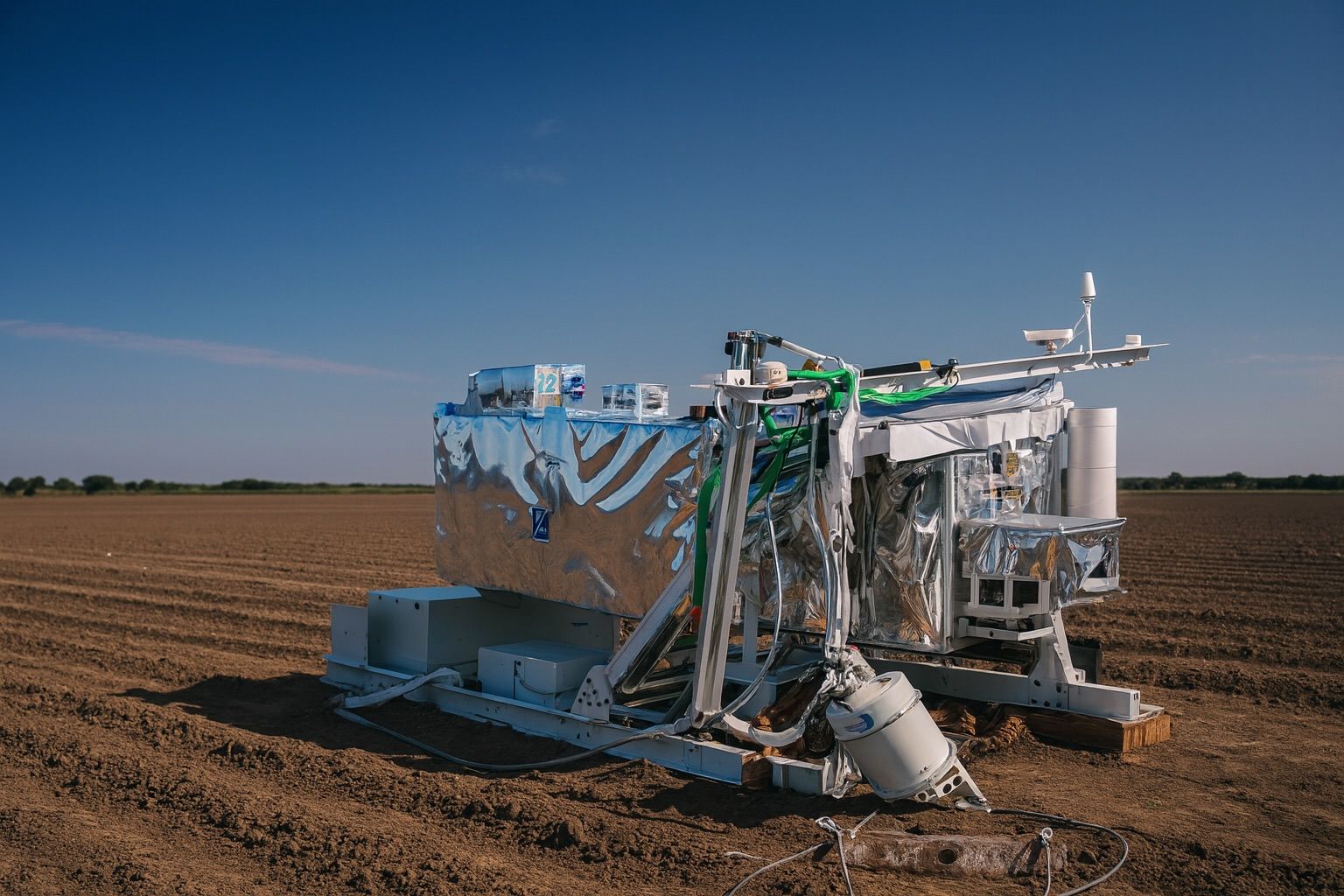- NASA Balloon Drops Into Texas Farm: A massive high-altitude NASA balloon payload unexpectedly landed in a West Texas crop field, startling local farmers [1] [2]. The SUV-sized research apparatus descended under a parachute near Edmonson, Texas, after drifting off course.
- Locals Spot Mystery in Sky: Residents Hayden and Ann Walter spotted a huge, parachute-like object floating silently over their farm before it crash-landed nearby [3] [4]. They alerted the Hale County Sheriff, soon learning the object belonged to NASA.
- Race to Recover the Payload:NASA teams raced to the scene to secure the fallen experiment. Deputies confirmed NASA personnel were already in the area searching for missing equipment when the Walters called [5]. Within hours, a recovery crew arrived to pack up the payload from the field [6].
- Balloon-Borne Space Observatory: The payload was part of a NASA scientific balloon mission carrying a telescope designed to capture clear images of stars, galaxies, and black holes from the edge of space [7]. Launched from New Mexico the day before, the balloon drifted ~200 miles before winds blew it off course into Texas [8] [9].
- Inside NASA’s Balloon Program: NASA operates stadium-sized stratospheric balloons that soar up to 120,000 feet (23 miles) high [10]. They can haul heavy instruments (up to 8,000 pounds) for cosmic ray studies, space telescopes, and tech demos at a fraction of the cost of satellite launches [11] [12]. Experts call these missions “high-reward at modest cost,” vital for testing new space technologies and training young scientists [13] [14].
Farm Family Stunned by Falling NASA Balloon
It was a quiet West Texas morning when the Walter family’s routine was broken by an unusual sight in the sky. Ann Walter was getting her young son ready for the day on October 2 when her husband, Hayden, burst in urging her to come outside [15]. Looking up, they saw a gigantic white balloon-like object attached to a parachute drifting silently overhead. “We couldn’t quite identify it,” Ann recalled of the moment they watched the mystery object float above their Hale County farm [16]. They managed to snap a few photos and video before the balloon disappeared from view over the horizon.
Moments later, Hayden guessed it must have landed nearby [17]. Unsure what exactly they had witnessed, Ann messaged a video to her parents. Her father’s immediate reaction: call the sheriff – whatever fell from the sky, he suspected, “wasn’t just a balloon.” Taking his advice, Ann phoned the Hale County Sheriff’s Office and reported the strange airborne object. To her shock, the deputy informed her that a NASA team was already out looking for a missing piece of experimental equipment in the area [18]. In other words, what the Walters saw drifting down was no simple weather balloon – it was NASA’s lost research payload coming back to Earth.
As the morning unfolded, the mystery unraveled quickly. A representative from NASA’s Columbia Scientific Balloon Facility (CSBF) named Garrison contacted Ann to gather details [19] [20]. “He was very nice and educational,” Ann noted, saying Garrison explained the situation and asked if they could help pinpoint where the object came down. Ann described the trajectory and promised to alert him if anyone found the equipment. Sure enough, later that morning Hayden’s father spotted the fallen payload sitting in an open field off a county road, not far from the Walters’ property [21]. The landowners had already discovered the bulky apparatus resting among their crops. Hayden dropped a GPS pin of the location and sent it to the NASA team, who had been canvassing the vicinity since daybreak [22].
“I’m so glad we saw this in the sky this morning and that I called the sheriff’s office,” Ann Walter wrote later that day. “What a cool memory and experience.” [23] [24] The farm family’s once-in-a-lifetime encounter turned them into unlikely collaborators in a NASA recovery operation. What began as a puzzling sunrise sighting ended with the Walters watching NASA engineers load up a huge fallen space experiment from their neighbor’s field. “It’s not every day you have NASA on your farm,” Ann joked on social media, marveling at the day’s events.
NASA Races to Recover a Fallen Space Experiment
Word that a NASA research device had parachuted into a Texas farm sparked an immediate scramble by authorities and space agency personnel. Media reports described “agents [rushing] to a West Texas farm” at dawn after the balloon “crash-landed in a crop field,” underscoring the urgency of the response [25]. In reality, the recovery was handled by NASA’s own team from the Columbia Scientific Balloon Facility, with coordination from local law enforcement. As soon as the payload’s descent was tracked, NASA dispatched experts to Texas to locate and secure the equipment before curious onlookers or the elements could damage it [26] [27].
The object in question was no trivial weather balloon—it was a sophisticated scientific payload about the size and weight of an SUV [28] [29]. Such payloads often contain delicate optics, sensors, and data recorders worth millions of dollars, as well as potentially hazardous materials (like pressurized canisters or batteries). Swift recovery is critical to protect the investment and any scientific data collected during the flight. In this case, NASA had been tracking the balloon’s trajectory through the night. When winds carried it into a rural stretch of Hale County, Texas, the team converged on the projected landing zone at first light, fanning out with tracking devices.
Thanks to the Walters’ tip and GPS coordinates, the NASA crew homed in on the downed payload by late morning. They moved in to inspect and disarm the instrument package, ensuring it was safe to transport. The scene on the farm drew a few astonished neighbors and sheriff’s deputies, but was orderly. The parachute and balloon envelope had detached as designed, leaving the heavy experiment module intact in the field. Technicians carefully collapsed and packed the parachute and balloon material, while others prepared the telescope payload for loading onto a flatbed truck.
By midday, NASA had the wayward equipment secured. A CSBF spokesperson confirmed that no one was injured and no property was significantly damaged during the landing. The Hale County Sheriff’s Office noted the cooperation of local residents was invaluable in recovering the device quickly. What could have been mistaken for crash debris or “space junk” turned out to be a planned science flight that simply ended a few hundred miles off target due to shifting winds. “The team was already trying to find and retrieve the equipment,” Ann Walter said, recalling the gratitude NASA expressed when she alerted them [30]. Within a few hours, the impromptu space scavenger hunt in the cotton fields of West Texas came to a successful close.
What Was This Balloon Carrying from Space?
The mystery object was part of a NASA astrophysics research mission flown on a high-altitude balloon. According to the NASA team, the payload included a cutting-edge telescope designed to capture clearer images of cosmic objects from the stratosphere [31]. By rising far above most of Earth’s atmosphere, the balloon-borne telescope could observe wavelengths of light (like infrared and X-rays) that are normally absorbed or distorted before reaching ground-based observatories [32]. This particular instrument was built to study stars, galaxies, and even black holes from near-space, as a “precursor to future satellite missions” [33]. In other words, it was a prototype or testbed for technology that might later be launched on an orbital space telescope.
NASA has not publicly named the specific experiment, but officials described it as a telescope with advanced imaging sensors. The goal was to achieve space-like observation quality without the expense of a rocket launch. “Flights like these enable us to get sharper images of space objects,” explained the CSBF representative Garrison, helping NASA decide on designs for upcoming satellite missions [34]. The approach allows scientists to validate new instruments in near-space conditions and make scientific observations that complement space telescopes like Hubble or James Webb.
The ill-fated balloon mission began at NASA’s Columbia Scientific Balloon Facility in Fort Sumner, New Mexico, a launch site for many stratospheric research balloons. The balloon was filled with helium and released on the afternoon of October 1. It ascended to the stratosphere and hovered around 120,000 feet altitude through the night [35]. Initially, winds kept it in eastern New Mexico (near Clovis and Portales), but overnight the upper-level wind patterns shifted and pushed the balloon east into Texas [36]. By early morning, controllers decided to terminate the flight – either automatically or via remote command – so the payload could descend safely by parachute. The planned landing zone may have been on open ranch land, but the change in winds meant it came down about 20 miles north of Lubbock, squarely in a farm field.
Thankfully, the descent was controlled and the parachute appears to have deployed properly, lowering the heavy telescope gently enough to avoid smashing to pieces. “It looked like a giant jellyfish coming down,” one local farmer commented on social media, noting the parachute’s canopy and dangling payload. The device did leave an imprint in the soft soil, but mission managers were relieved to find the equipment largely undamaged upon retrieval. Any data recorded during the flight could potentially be recovered for analysis.
NASA will likely inspect the hardware back at its facility to determine why the flight ended where it did. Unexpected shifts in stratospheric winds can sometimes carry balloons off-course – one reason these missions include onboard cut-down mechanisms to bring them down before they drift over populated areas or into difficult terrain [37]. In this case, the “unscheduled landing” in a farm field was a minor hiccup in an otherwise successful research flight. The telescope got several hours of observing time at the edge of space, and NASA got its payload back – with an assist from some surprised Texans.
Inside NASA’s High-Altitude Balloon Program
What landed in Texas was not alien spacecraft or orbital debris, but a product of NASA’s long-running Scientific Balloon Program. For over 30 years, NASA has been launching giant balloons to carry scientific experiments to the stratosphere [38]. These are no ordinary balloons – when fully inflated at altitude, they can be as big as a football stadium in diameter [39] [40]. The balloon envelope is made of ultra-thin polyethylene film, yet it can hold millions of cubic feet of helium and lift payloads weighing several tons.
Each year, NASA typically flies 10 to 15 balloon missions from sites around the world [41]. Launch campaigns are conducted in places like Fort Sumner (New Mexico), Palestine (Texas), Sweden, Antarctica, and New Zealand, taking advantage of seasonal wind patterns. At peak altitude (100,000–130,000 feet), these balloons float above ~99% of Earth’s atmosphere [42] [43]. That creates a near-space environment with extremely thin air and cold temperatures, ideal for certain research:
- Astronomy & Astrophysics: Telescopes on balloons can observe cosmic phenomena (stars, galaxies, cosmic rays) with clarity approaching space telescopes. For example, NASA has flown instruments like X-Calibur to hunt for X-ray signals from black holes [44] and ASTHROS to map interstellar clouds in infrared [45] [46], tasks made possible by rising above atmospheric interference.
- Earth Science & Weather: Some balloons carry instruments to study Earth’s atmosphere, climate, or near-space environment. By sampling high-altitude air or radiation, they help validate satellite data.
- Technology Testbeds: Balloons are often used to test new space hardware (detectors, electronics, even small satellites) in conditions similar to space. The relatively quick turnaround means engineers can iterate and improve designs before committing them to costly orbital launches [47].
Operating these leviathans is both an art and a science. A launch requires perfect weather – even moderate winds can spell trouble. Crews delicately fill the balloon on a wide-open field and release it, with the payload hanging from a long tether. Once aloft, the balloon rises until the surrounding air’s density causes it to stop ascending (around 30–40 km up). It then drifts with the winds at that float altitude. Mission control can release ballast or vent gas to adjust altitude slightly, but generally the path is at the mercy of the atmosphere. Flights can last from a few hours to multiple days or even weeks. (In fact, NASA and commercial partners have flown ultra-long-duration balloons that circled the globe on wind currents, staying up for 30+ days.)
Crucially, these balloons are uncrewed and fully recoverable. At the end of a mission, or if an unexpected issue arises, NASA will send a radio command to cut the payload loose. A parachute deploys to slow its fall. The balloon itself vents its gas and often separates to fall away from the payload. Both the payload and balloon material return to Earth, usually in a pre-selected broad recovery zone. Because they descend from such heights, the landing sites can be spread over hundreds of miles. Recovery teams track the payload via GPS and radio beacons, then travel (sometimes by helicopter or off-road vehicles) to retrieve the hardware.
Not every flight goes flawlessly. “There is no question in our minds that balloon launches are fragile processes,” one NASA investigator said after a major mishap [48]. He was referring to a notorious 2010 incident in Australia when a giant NASA balloon went out of control during launch and crashed, dragging its heavy telescope payload across the ground. Spectators ran for safety as the gondola tore through a fence and smashed into a parked car [49]. The expensive gamma-ray telescope was partially destroyed, though miraculously no one was hurt. NASA’s review board found dozens of causes, from inadequate training to poor risk planning [50] [51]. The program instituted stricter safety procedures after that. Mishaps are rare, but as that case showed, these massive balloons can become unguided hazards if something goes wrong.
In the Texas landing, by contrast, the balloon performed as designed through launch and float, and the primary surprise was the landing location, not a catastrophic failure. The incident does highlight one trade-off of balloon missions: you don’t have precise control of where they land. NASA works hard to pick flight trajectories that avoid populated areas, but Mother Nature can always introduce some uncertainty. That’s one reason why the agency typically notifies aviation authorities and sometimes local communities about balloon flights – so people don’t panic if they see an unfamiliar object in the sky or coming down. (It’s worth noting that earlier in 2023, a high-altitude Chinese balloon sparked international drama when it traversed the U.S., before being shot down. NASA’s scientific balloons, however, are a well-established program operated transparently for research, posing little security risk.)
High Science at Low Cost
Why does NASA still use “old-fashioned” balloons in the era of advanced rockets and satellites? The answer comes down to cost, speed, and risk. Balloon missions are relatively cheap and quick to deploy, yet can achieve important scientific goals. “Balloon missions don’t only have lower costs compared to space missions, they also have shorter times between early planning and deployment,” NASA explains – meaning researchers can go from an idea to a flight in a few years or less [52]. In contrast, a space telescope or satellite might take a decade and a billion-dollar budget to build and launch.
This agility lets balloons serve as testbeds for cutting-edge technology. “They can accept the higher risks associated with using new or state-of-the-art technologies that haven’t yet flown in space,” NASA’s Astrophysics Division notes [53]. If a novel sensor or experimental instrument fails on a balloon, it’s a setback but not a disaster – no crew is endangered and the project costs are modest. But if it works, scientists gain confidence to use that technology on a future satellite or crewed spacecraft. As JPL engineer José Siles, project manager for the ASTHROS balloon telescope, put it: “Balloon missions offer high-rewards at modest cost… The mission will pave the way for future space missions by testing new technologies.” [54] By working through challenges in balloon flights, NASA can “set the stage for future missions to reap the benefits of these new technologies.” [55]
The science return can be remarkable for the investment. Balloon-borne experiments have made significant discoveries over the years – from detecting primordial particles in cosmic rays, to mapping the Cosmic Microwave Background radiation, to capturing the first images of celestial objects from a telescope dangling beneath a balloon [56]. Researchers also use balloons to conduct critical Earth science (for example, ozone measurements that informed climate agreements came partially from balloon data). All this at a tiny fraction of the price of a satellite launch – a large NASA balloon flight might cost a few million dollars, versus hundreds of millions for an orbital mission.
Of course, balloons cannot replace satellites or rockets for many purposes. They have limited flight durations and can only reach the stratosphere (far below true space, which starts about 100 km up). They also carry much smaller payloads than heavy rockets can lift to orbit. But for certain experiments, especially in astronomy and atmospheric science, they hit a sweet spot. Scientists get near-space conditions “above 99% of Earth’s atmosphere” [57] to validate ideas and gather data, without needing to go to space permanently.
A Dramatic but Successful Conclusion
Back in Hale County, Texas, the saga of the wayward NASA balloon ended with relief and a touch of local fame. By the afternoon of October 2, the Walters’ farm was back to normal – aside from some minor crop disturbance where the payload landed – and the huge white balloon and parachute were gone, packed into NASA trucks. The agency thanked the community for their help and noted the operation was a success “thanks to quick reporting by eyewitnesses.” Ann Walter’s Facebook post about the event went viral in the area, as neighbors joked about “aliens landing in the cotton field” and marveled that a NASA experiment literally dropped out of the sky in their little town.
NASA will analyze the recovered telescope and data to see what can be learned from the unplanned detour. It’s possible the mission gathered useful astronomical observations during its flight. Engineers will also examine why the balloon flew off the intended path – valuable information for improving wind models and balloon navigation in the future. These lessons will feed into the next generation of high-altitude experiments.
For the residents who witnessed it, this unexpected encounter brought home the excitement of discovery. “If you saw something in the sky at dusk last night, more than likely this was it!” Ann Walter wrote, encouraging others who had noticed the bright dot overhead not to worry [58]. It was a NASA balloon, not a UFO or spy craft. And it carried not aliens, but the tools of science – a telescope peering into the secrets of the universe, hitching a ride on the winds of the upper atmosphere.
In the end, a sleepy farm town became an impromptu landing site for cutting-edge research. The story of the Texas balloon landing underscores both the thrill and unpredictability of exploration. As one commentator quipped, NASA’s motto could well be “science isn’t always rocket science – sometimes it’s balloon science.” And sometimes that balloon science can quite literally drop into your backyard, turning an ordinary day into a page out of an adventure. The Hale County incident will be remembered as a dramatic example of how big science and everyday life can intersect in the most unexpected ways – with curious farmers, a fallen “space balloon,” and NASA scientists all coming together in a West Texas field to recover a piece of the cosmos.
Sources: Local news reports (KCBD, Chron, LMT) on the Texas balloon landing [59] [60]; NASA and JPL background on the Scientific Balloon Program [61] [62]; Daily Mail via abdpost summary of the incident [63]; NASA mishap investigation report (2010) [64] [65]; statements from NASA officials and experts [66] [67]; social media posts by eyewitness Ann Walter [68] [69].
References
1. www.abdpost.com, 2. www.chron.com, 3. www.abdpost.com, 4. www.chron.com, 5. www.chron.com, 6. www.lmtonline.com, 7. www.chron.com, 8. www.chron.com, 9. m.netdania.com, 10. www.lmtonline.com, 11. www.lmtonline.com, 12. www.nasa.gov, 13. www.nasa.gov, 14. www.nasa.gov, 15. www.chron.com, 16. www.chron.com, 17. www.chron.com, 18. www.chron.com, 19. www.chron.com, 20. www.lmtonline.com, 21. www.chron.com, 22. www.chron.com, 23. www.chron.com, 24. www.lmtonline.com, 25. www.abdpost.com, 26. www.chron.com, 27. www.lmtonline.com, 28. www.chron.com, 29. www.chron.com, 30. pan.bg, 31. www.chron.com, 32. www.nasa.gov, 33. www.chron.com, 34. www.lmtonline.com, 35. www.lmtonline.com, 36. www.chron.com, 37. m.netdania.com, 38. www.nasa.gov, 39. www.nasa.gov, 40. www.nasa.gov, 41. www.nasa.gov, 42. www.nasa.gov, 43. www.nasa.gov, 44. www.livescience.com, 45. www.nasa.gov, 46. www.nasa.gov, 47. www.nasa.gov, 48. www.nasa.gov, 49. www.nasa.gov, 50. www.nasa.gov, 51. www.nasa.gov, 52. www.nasa.gov, 53. www.nasa.gov, 54. www.nasa.gov, 55. www.nasa.gov, 56. spacewatchafrica.com, 57. www.nasa.gov, 58. www.lmtonline.com, 59. www.chron.com, 60. www.lmtonline.com, 61. www.nasa.gov, 62. www.lmtonline.com, 63. www.abdpost.com, 64. www.nasa.gov, 65. www.nasa.gov, 66. www.nasa.gov, 67. www.nasa.gov, 68. www.lmtonline.com, 69. www.lmtonline.com










